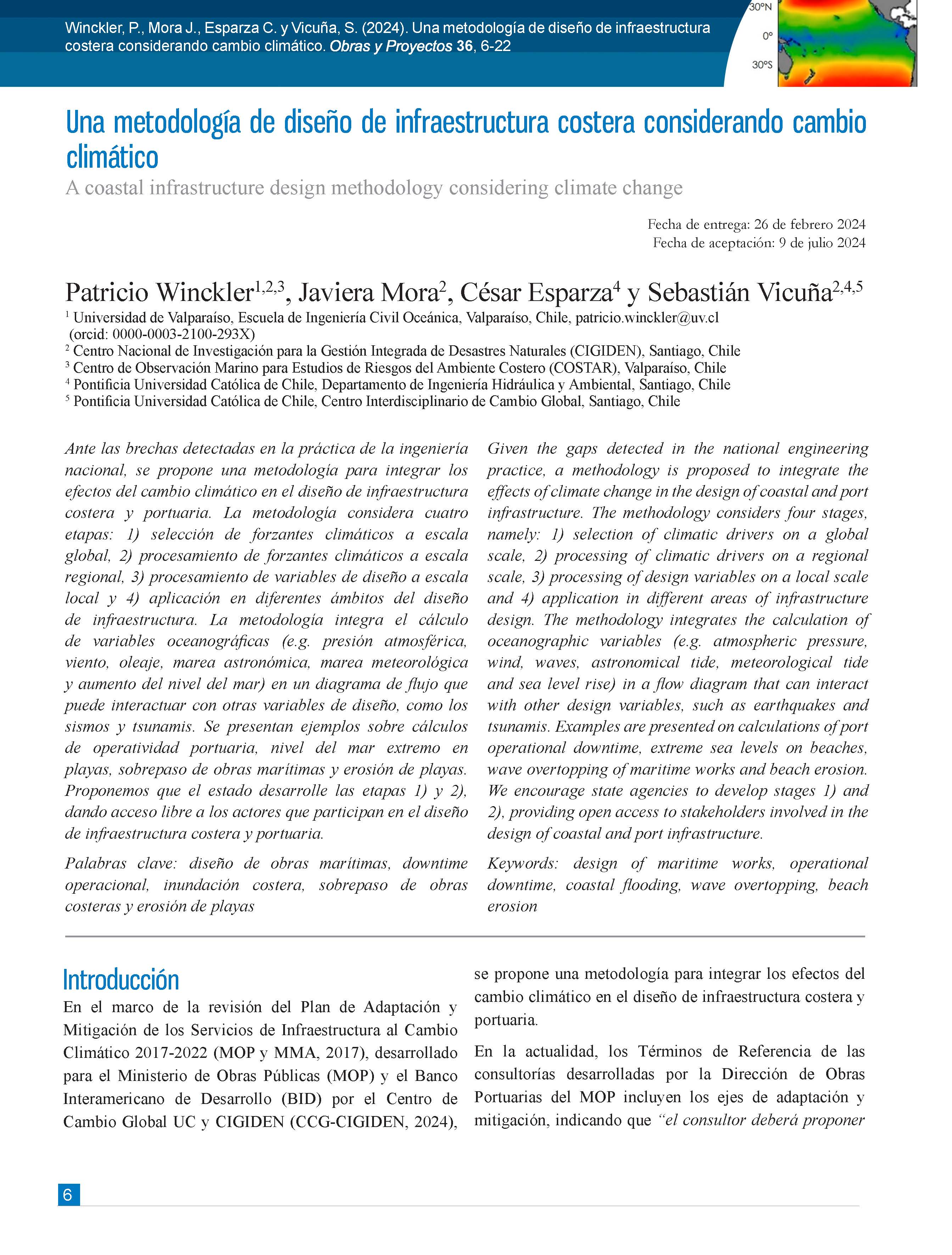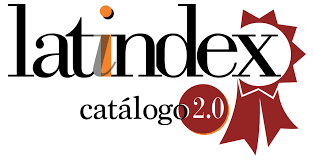A coastal infrastructure design methodology considering climate change
DOI:
https://doi.org/10.21703/0718-2813.2024.36.2998Keywords:
Design of maritime works, Operational downtime, Coastal flooding, Wave overtopping, Beach erosionAbstract
Given the gaps detected in the national engineering practice, a methodology is proposed to integrate the effects of climate change in the design of coastal and port infrastructure. The methodology considers four stages, namely: 1) selection of climatic drivers on a global scale, 2) processing of climatic drivers on a regional scale, 3) processing of design variables on a local scale and 4) application in different areas of infrastructure design. The methodology integrates the calculation of oceanographic variables (e.g. atmospheric pressure, wind, waves, astronomical tide, meteorological tide and sea level rise) in a flow diagram that can interact with other design variables, such as earthquakes and tsunamis. Examples are presented on calculations of port operational downtime, extreme sea levels on beaches, wave overtopping of maritime works and beach erosion. We encourage state agencies to develop stages 1) and 2), providing open access to stakeholders involved in the design of coastal and port infrastructure.
References
Baldan, D., Coraci, E., Crosato, F., Ferla, M., Bonometto, A. and Morucci, S. (2022). Importance of non-stationary analysis for assessing extreme sea levels under sea level rise. Natural Hazards and Earth System Sciences 22(11), 3663-3677.
Beyá, J., Álvarez, M., Gallardo, A., Hidalgo, H. and Winckler, P. (2017). Generation and validation of the Chilean Wave Atlas database. Ocean Modelling 116, 16–32.
Beyá, J., Álvarez, M., Gallardo, A., Hidalgo, H., Aguirre, C., Valdivia, J., Parra, C., Méndez, L., Contreras, C., Winckler, P. et al. (2016). Atlas de Oleaje de Chile. Universidad de Valparaíso: Valparaíso, Chile, ISBN: 978-956-368-194-9. https://oleaje.uv.cl/descargas.html
Bruun, P. (1962). Sea-level rise as a cause of shore erosion. Journal of the Waterways and Harbors Division 88(1), 117-130.
CCG-CIGIDEN (2024). Evaluación de término plan de adaptación y mitigación de los servicios de infraestructura al cambio climático 2017-2022. Reporte Final, 15 de enero de 2024.
CEPAL (2015). Efectos del cambio climático en la costa de América Latina y el Caribe. Dinámicas, tendencias y variabilidad climática. http://repositorio.cepal.org/bitstream/handle/11362/3955/4/S1500961_es.pdf
Church, J.A., Clark, P.U., Cazenave, A., Gregory, J.M., Jevrejeva, S., Levermann, A., Merrifield, M.A., Milne, G.A., Nerem, R.S., Nunn, P.D., Payne, A.J., Pfeffer, W.T., Stammer D. and Unnikrishnan, A.S. (2013). Sea Level Change. In Climate Change 2013: The Physical Science Basis, Contribution of Working Group I to the Fifth Assessment Report of the Intergovernmental Panel on Climate Change; Cambridge University Press, Cambridge, UK and New York, NY, USA, vol. 13, 1137–1216. https://www.ipcc.ch/report/ar5/wg1/
Esparza, C. (2023). Extreme sea level projections in Cartagena bay towards mid and end of the twenty-first century under RCP8.5 scenario. MSc thesis, P. Universidad Católica de Chile, Santiago, Chile.
Gironás, J. y Yáñez, G. (2021). Impactos y adaptación en infraestructura. En Cambio Climático en Chile. Ciencia, Mitigación y Adaptación. Castilla, J.C. et al. (eds.). Centro de Cambio Global UC. Santiago, Chile, https://ediciones.uc.cl/cambio-climatico-en-chile-ciencia-mitigacion-yadaptacion-config-9789561424227.html
Haasnoot, M., Brown, S., Scussolini, P., Jimenez, J.A.,Vafeidis, A.T. and Nicholls, R.J. (2019). Generic adaptation pathways for coastal archetypes under uncertain sea-level rise. Environmental Research Communications 1(7), 071006.
IPCC (2021). Summary for policymakers. In: Climate Change 2021: The Physical Science Basis. Contribution of Working Group I to the Sixth Assessment Report of the Intergovernmental Panel on Climate Change. MassonDelmotte, V., P. Zhai, A. Pirani, S.L. Connors, C. Péan, S. Berger, N. Caud, Y. Chen, L. Goldfarb, M.I. Gomis, M. Huang, K. Leitzell, E. Lonnoy, J.B.R. Matthews, T.K. Maycock, T. Waterfield, O. Yelekçi, R. Yu, and B. Zhou (eds.). Cambridge University Press, Cambridge, UK and New York, NY, USA, 3-34, https://doi.org/10.1017/9781009157896
IPCC (2019). IPCC Special Report on the Ocean and Cryosphere in a Changing Climate. H.O. Pörtner, D.C. Roberts, V. Masson-Delmotte, P. Zhai, M. Tignor, E. Poloczanska, K. Mintenbeck, A. Alegría, M. Nicolai, A. Okem, J. Petzold, B. Rama, N.M. Weyer (eds.). Cambridge University Press, Cambridge, UK and New York, NY, USA, https://doi.org/10.1017/9781009157964
IPCC (2013). Summary for policymakers. In: Climate Change 2013: The Physical Science Basis. Contribution of Working Group I to the Fifth Assessment Report of the Intergovernmental Panel on Climate Change. Stocker, T.F., D. Qin, G.K. Plattner, M. Tignor, S.K. Allen, J. Boschung, A. Nauels, Y. Xia, V. Bex and P.M. Midgley (eds.). Cambridge University Press, Cambridge, UK and New York, NY, USA.
Lemos, G., Menendez, M., Semedo, A., Camus, P., Hemer, M., Dobrynin, M. and Miranda, P.M. (2020). On the need of bias correction methods 776 for wave climate projections. Global and Planetary Change 186, 103109.
Luijendijk, A., Hagenaars, G., Ranasinghe, R., Baart, F., Donchyts, G. and Aarninkhof, S. (2018). The state of the world’s beaches. Scientific Reports 8: 6641.
Martínez, C., Winckler, P., Agredano, R., Esparza, C., Torres, I. and Contreras-López, M. (2021). Coastal erosion in sandy beaches along a tectonically active coast: The Chile study case. Progress in Physical Geography: Earth and Environment 46(2), 250-271.
Melo, O., Samaniego, J., Carbonell, J.F., Jadrijevic, M. y Briceño, S. (2023). Costos asociados a la inacción frente al cambio climático en Chile: síntesis, Documentos de Proyectos (LC/TS.2023/45), Comisión Económica para América Latina y el Caribe CEPAL, Santiago, Chile, https://repositorio.cepal.org/bitstream/handle/11362/48880/1/S2300039_es.pdf
Mentaschi, L., Vousdoukas, M., Voukouvalas, E., Sartini, L., Feyen, L., Besio, G. and Alfieri, L. (2016). The transformed-stationary approach: a generic and simplified methodology for non-stationary extreme value analysis. Hydrology and Earth System Sciences 20(9), 3527-3547.
MOP y MMA (2017). Plan de adaptación y mitigación de los servicios de infraestructura al cambio climático 2017-2022, https://biblioteca.digital.gob.cl/items/0c06899e-8b85-46bd-b8ee-566de6649d94
Morim, J., Trenham, C., Hemer, M., Wang, X., Mori, N., Shimura, T., Timmermans, B., Mentaschi, L., Casas-Prat, M., Semedo, A., Dobrynin, M., Camus, P., Bricheno, L., Feng, Y. and Erikson, L. (2019). COWCLIP2.0 ocean wave climate and extremes statistics from CMIP5-drivenwave models. Australian Ocean Data Network. https://dx.doi.org/10.26198/5d91a9d00d60d
Muis, S., Apecechea, M.I., Dullaart, J., de Lima Rego, J., Madsen, K.S., Su, J., Yan, K. and Verlaan, M. (2020). A high-resolution global dataset of extreme sea levels, tides, and storm surges, including future projections. Frontiers in Marine Science 7:263. doi:10.3389/fmars.2020.00263/full
PIANC (1995). Criteria for movements of moored ships in harbours. A Practical Guide. Report of Working Group no. 24. Supplement to Bulletin no. 88. Brussels, Belgium PPEE (1999, 2007). Recommendations for the design of the maritime configuration of ports, approach channels and harbour basins. ROM 3.1-99. English version 2007. Puertos de Estado, Madrid, España.
Saha, S., Moorthi, S., Pan, H.L., Wu, X., Wang, J., Nadiga, S., Tripp, P., Kistler, R., Woollen, J., Behringer, D., Liu, H. et al. (2010). The NCEP climate forecast system reanalysis. Bulletin of the American Meteorological Society 91(8), 1015-1058.
Stockdon, H.F., Holman, R.A., Howd, P.A. and Sallenger Jr, A.H. (2006). Empirical parameterization of setup, swash, and runup. Coastal Engineering 53(7), 573-588.
USACE (2006). Coastal Engineering Manual. Chapter 5, Fundamentals of Design. Part VI. USA.
Winckler, P., Esparza, C., Mora, J., Agredano, R., Contreras-López, M., Larraguibel, C., Melo, O. Contreras (2022a). Impactos del cambio climático en las costas de Chile. En Hacia una Ley de Costas en Chile: bases para una Gestión integrada de Áreas Litorales. Martínez, C. et al. (eds). Serie GEOlibro N°38, Instituto de Geografía, Pontificia Universidad Católica de Chile, Santiago. https://geografia.uc.cl/destacados/2543-ya-disponiblegeolibro-hacia-una-ley-de-costas-en-chile-bases-parauna-gestion-integrada-de-areas-litorales
Winckler, P., Esparza, C., Mora, J., Melo, O. Bambach, N. Contreras-López, M. and Sactic, M.I. (2022b). Impacts in ports on a tectonically active coast for climate-driven projections under the RCP 8.5 scenario: 7 Chilean ports under scrutiny. Coastal Engineering Journal 64(3), 387-405 https://doi.org/10.1080/21664250.2022.2088194
Winckler, P., Agredano, R., Esparza, C., Melo, O., Sactic, M.I. and Martínez, C. (2023). Projections of beach erosion and associated costs in Chile. Sustainability 15(7), 5883. https://doi.org/10.3390/su15075883

Downloads
Published
Issue
Section
License

This work is licensed under a Creative Commons Attribution-NonCommercial 4.0 International License.







